
Mercedes W14: plenty of room for creativity in a myriad of technical evolutions!
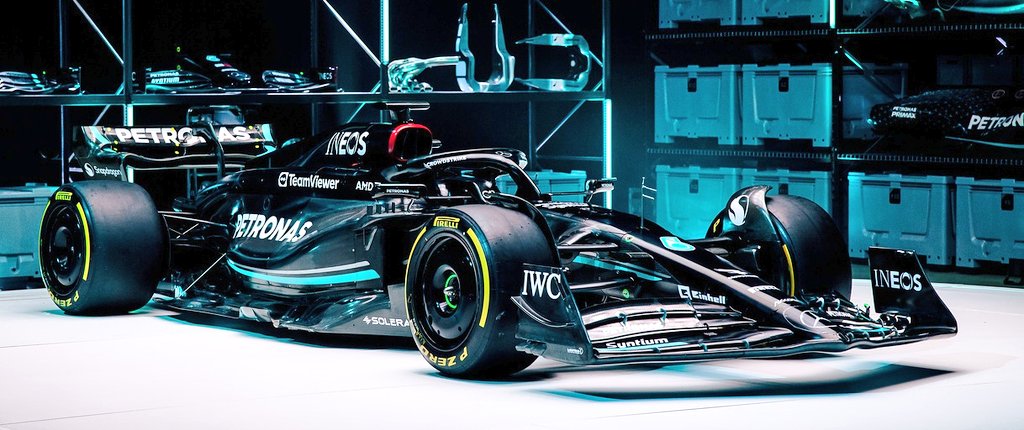
Photo: Twitter - Albert Fabrega
Back to black: black livery looking for a few kg less!
The first images of the new Silver Arrow show that… it is no longer silver! In fact, Mercedes has returned to the black livery used in the two-year period 2020-2021... This time, however, there are no ethical or marketing reasons to do with it, as much as the need to contain the vehicle mass within the 798 kg prescribed by the Technical Regulations. In fact, only a small portion of the car bodywork is painted in black, while the rest is all bare carbon fiber... in some way, replicating what was done in the early 1950s (in which it was the aluminum of the bodywork that appeared), history repeats itself for Mercedes.
Higher nose and new front wing with endplate that will cause controversy
The new parts are detectable starting directly from the nose tip, which is now higher than on the past W13. Nothing substantial, but connecting the nose to the front wing mainplane resulted in freeing up space under the front wing itself, to the advantage of the airflow channeling into the Venturi channels, placed behind; on the other hand, the same design philosophy was followed by Alpine on its A523 and, shortly last year, by Aston Martin on its AMR22.
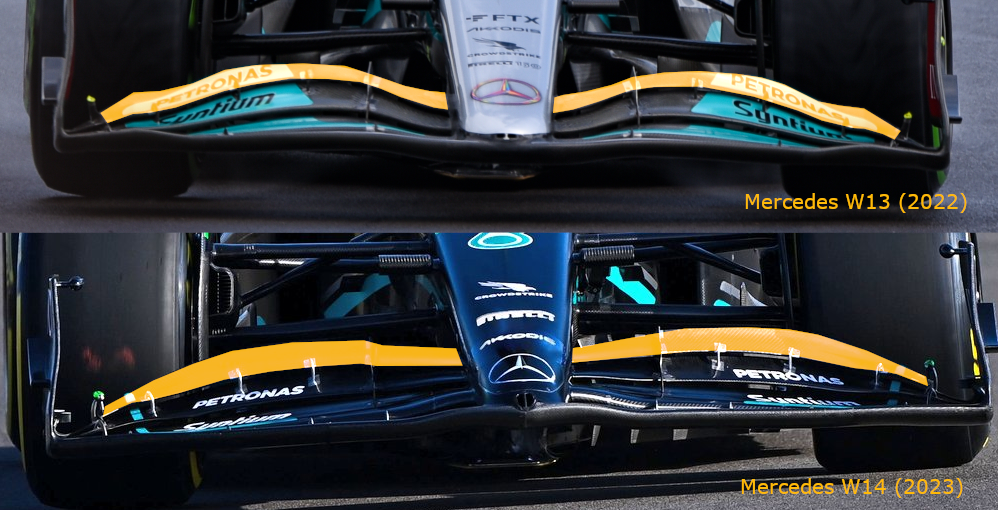
The front wing has also a different design compared to last year, while aiming for that outwash effect that all teams are now looking for, in order to seal the turbulent flows generated by the front tyres. As can be seen from the comparison above, the last flap now has a less curved shape in the area where it connects to the lateral surfaces of the nose: the coexistence between this modification and the nose raising is not accidental, since the Brackley engineers have deliberately decided to direct the airflow towards the Venturi channels no longer from the upper part of the front wing, but from the lower side - which is supposed to be less turbulent!

Photo: Mercedes-AMG PETRONAS F1 Team
The front wing endplates, highlighted in yellow, incredibly keep the solution - also introduced by Mercedes in the 2022 Miami Grand Prix - which the FIA had decided to ban. The “bones of contention” are the connecting portions between the wing flaps and the endplate itself (zones colored in different shades of red, to be clear): in the rules interpretation that the FIA would like to see applied by the teams, the examined zone should present continuous profiles, in order to minimize the turbulent wake left downstream.
Therefore, although the regulation relating to the endplates was rewritten to ban the aforementioned solution last year, the engineers who designers the W14 have thought of geometries that could also outsmart the new standard, thus keep generating useful outwash. This confirmed the creativity that we will be able to observe even later, in the course of our technical analysis.

Photo: Mercedes-AMG PETRONAS F1 Team
The front suspension maintains the push-rod configuration, but there are also adaptations to the geometry of each suspension arm: in fact, as on the Ferrari SF-23, the steering rod (highlighted in yellow in the image above) has been aligned with the lower triangle of the suspension - to the full advantage of aerodynamic smoothness.
The particular fairing behind the arms of the upper suspension triangle has also been maintained, once again in order to direct the flows downwards and generate the minimum possible amount of aerodynamic resistance.
Have the zeropods been maintained? Meanwhile, the W14 features an engine cover with two brand new channels!
Like many other cars in this 2023, it is in the central area of the new W14 that the most creative and innovative technical details can be found. Basically, it cannot be said that Mercedes has 100% maintained the "zeropods" configuration with regard to the sidepods; with this term, we refer to almost non-existent sidepods, in an attempt to maximize the airflow towards the diffuser.
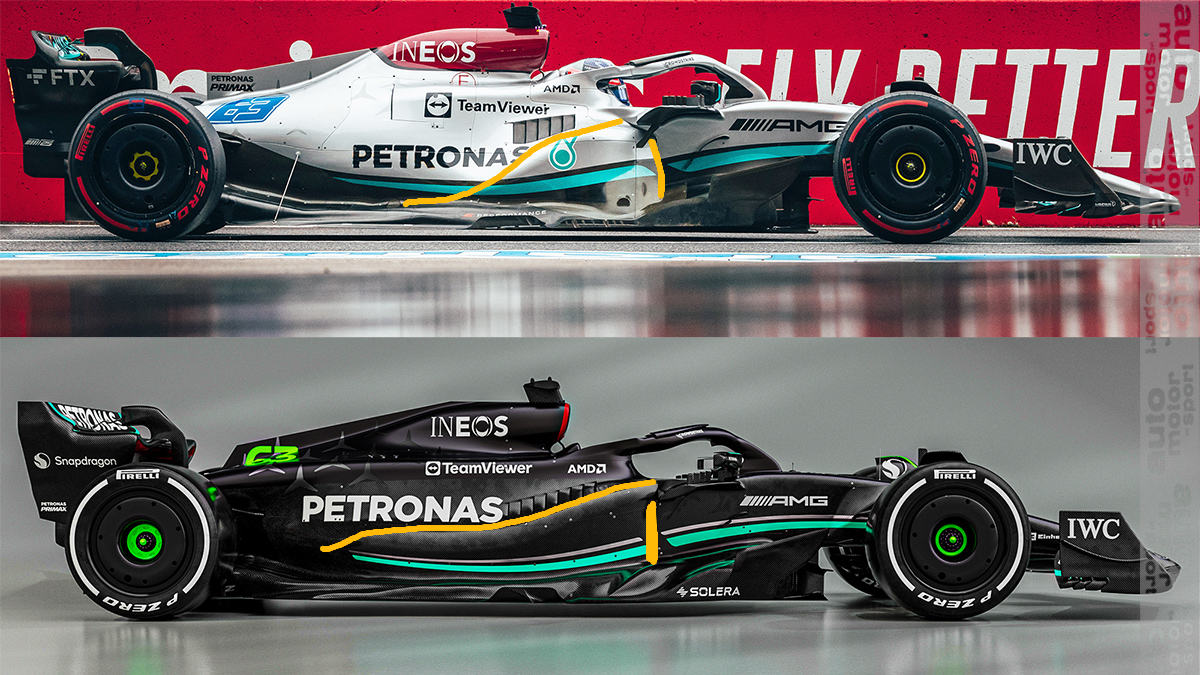
Photo: Auto Motor und Sport
Examining the central area of the new car in detail, it can be seen a vertical radiator inlet with a rectangular shape, so no longer wider at its bottom portion; the trend of the sidepods is now more elongated, and the external profile remains higher and a little wider as the sidepods themselves proceeds towards the rear, in an attempt to at least partially shield the bulky frontal area of the rear tyres.
If we wanted to pigeonhole the aerodynamic philosophy chosen by Mercedes this year, we could say that it is somewhere between Ferrari and Red Bull:
- Like Ferrari, they are not looking for a downwash effect that brings more air to the diffuser by following the upper wall of the sidepods themselves. In other words, the lower channel is preferred to the upper one;
- Like Red Bull, they try to feed the beam wing as much as possible with a consistent and "clean" airflow; on this matter, however, it is better to spend a few more words in the continuation of our analysis…
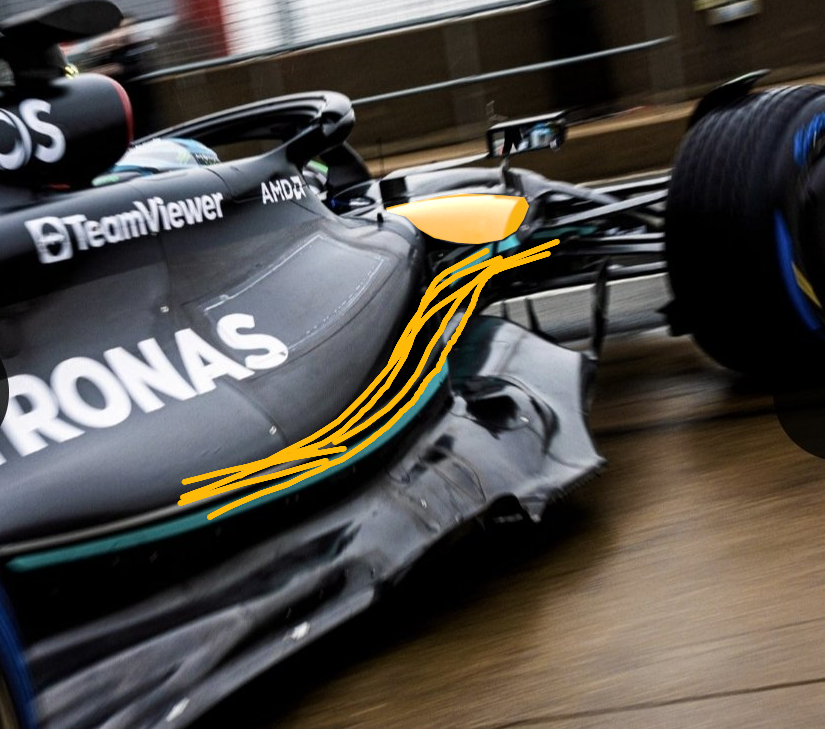
Photo: Mercedes-AMG PETRONAS F1 Team
Together with the zeropods (with the necessary clarifications made), a peculiarity of the last W13 also remains: the shroud of the side impact protection structures (SIPS) creates a sort of fairing with a downwash function, which - if in itself is to the detriment of the downforce - it is certainly much more helpful in guiding the airflow towards the sidepods. On the W14 this wing is shaped differently than on the W13, as well as having been slightly compacted in size.
This configuration, which will necessarily have to work in synergy with the underfloor, will be under the microscope of the Brackley engineers themselves. In fact, in 2022 they paid a similar choice with a strong porpoising which - ultimately - compromised their performance and aerodynamic development until the end of the season. Only in the last few Grands Prix, thanks to an already concluded development of the Ferrari F1-75 and Red Bull RB18, was brought home a race win with George Russell (in Brazil).
"I've always believed that in this sport you have to be a little daring, and I can say that I'm still proud of the solutions that were put into the car last year"
Toto Wolff
Returning to the present, as it is legitimate to imagine, the underfloor of the car was kept well hidden. Even at the shakedown at Silverstone, the W14 ran with a specification similar to the one used on the final part of last World Championship.
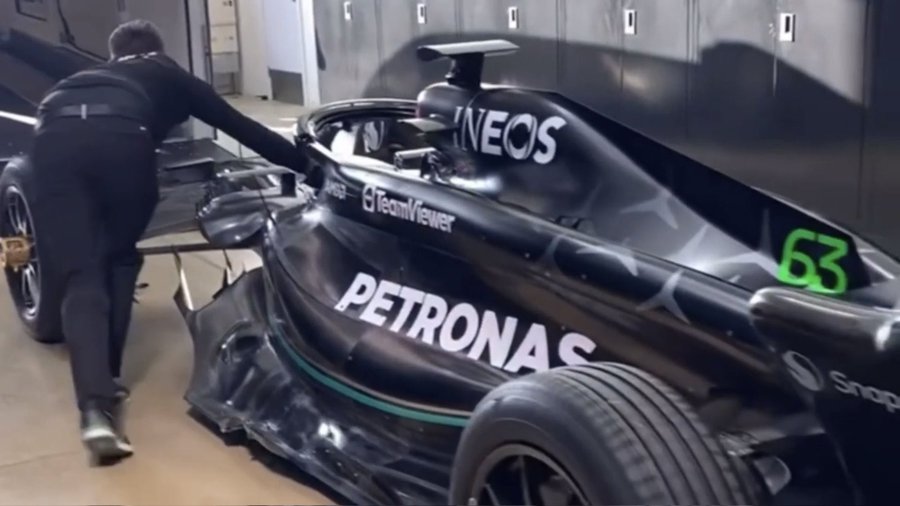
Photo: Twitter - EngineMode11
That said, it's time to talk about the elephant in the room: the radical and innovative shapes of the engine cover. Looking only at the renderings, we would be led to think of a simple "centerline cooling", i.e. a rather centralized positioning of the radiators (hypothesis that would go well with narrow sidepods like those analyzed).
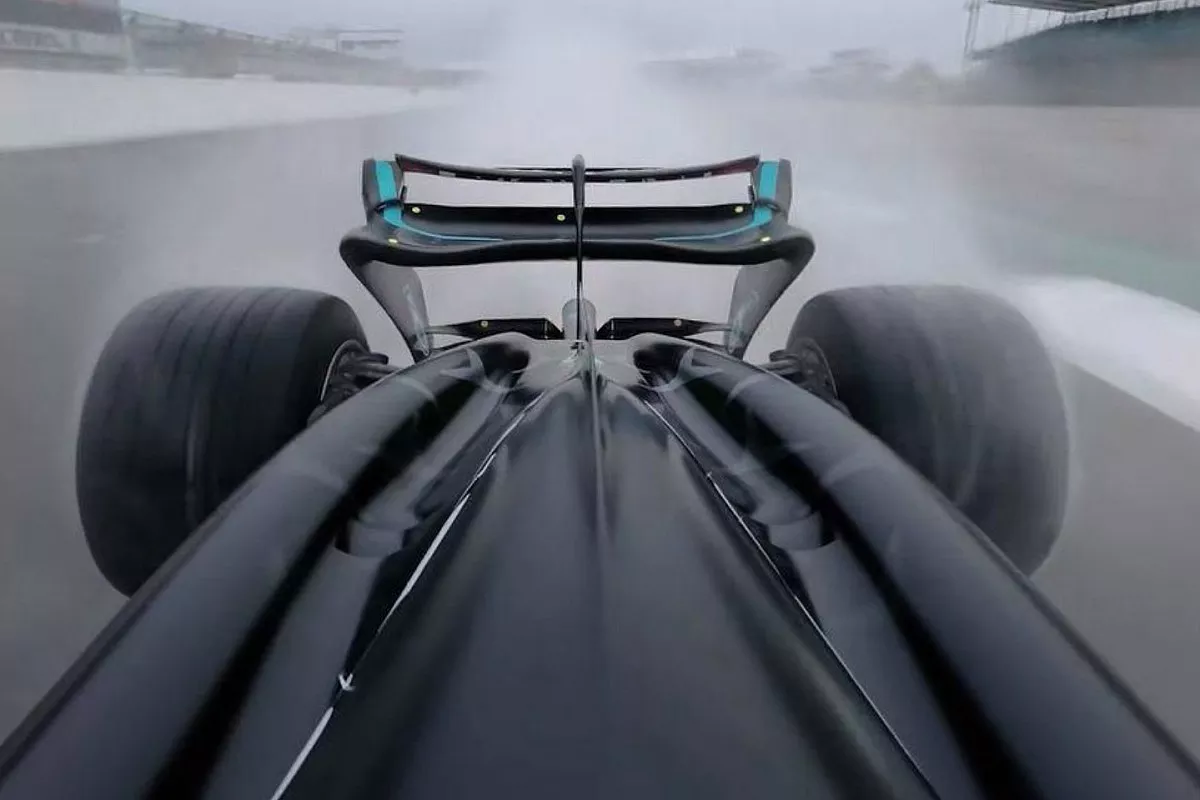
Photo: Mercedes-AMG PETRONAS F1 Team
In reality, as can be seen in a snapshot taken from the aforementioned shakedown at Silverstone, the aerodynamic department has gone much further… The engine cover sides feature two very rounded and prominent channels, which extend as far as at the hot air outlet.
It is important to note that two series of "louvres" are arranged along both of these channels, the purpose of which is to extract hot air from the Power Unit and keep temperatures under control. Once this air has been extracted, it is likely to think of the two channels as a way to direct it towards the beam wing, which then finds itself receiving a greater airflow volume than it would in the case of a decentralized cooling layout.
The beam wing, in current Formula 1 single-seaters, is far more important than one might think… In fact, in addition to generating downforce by itself, if well designed (and fed by a consistent airflow) it can work in a very efficiently with:
- The rear wing, immediately above it;
- The diffuser, located immediately below it;
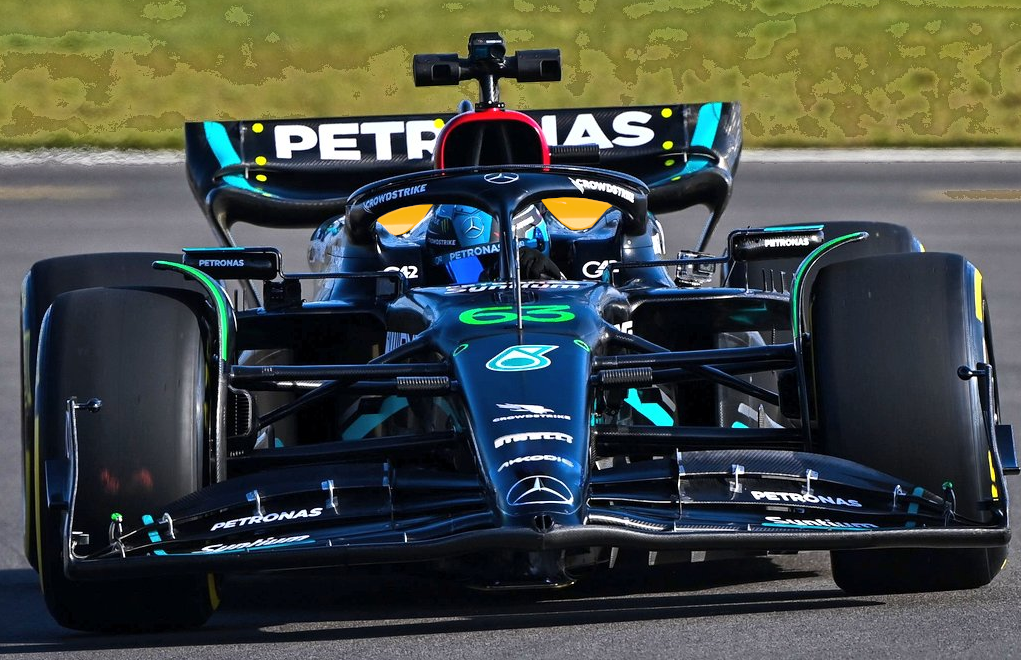
Photo: Twitter - Albert Fabrega
But it’s not over! The same channels, observed from the front, free up two volumes (highlighted in yellow in the image) in which to confine the turbulence generated in the cockpit area. This need is not exclusive to Mercedes: even Ferrari, on the SF-23, has implemented a series of fins and fairings on the halo and on the cockpit sides. However, I believe the solution applied to the Mercedes is in its principle smarter, given that it combines 3 different needs with a single design choice.
Yes, you read correctly, 3 requirements… in addition to limiting the turbulence generated by the cockpit and directing the hot gases towards the beam wing, the two channels fulfill a third function: to form a natural extension of the Halo, which is now more integrated into the whole project (and by virtue of this, will be led to generate less drag).
Rear end with few upgrades, but expect some surprises…
Together with the underbody, the other macro-area kept well hidden and very similar to the W13 is the rear end. The most important change, in fact, is about the rear suspension.
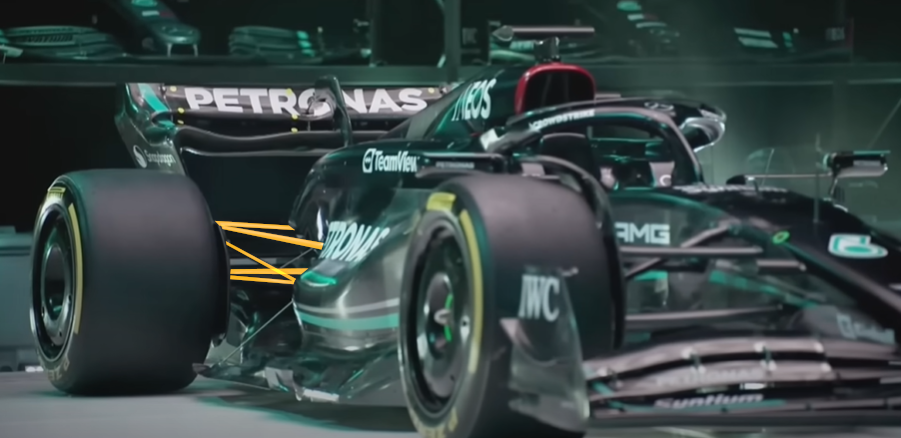
Photo: Mercedes-AMG PETRONAS F1 Team
While maintaining the consolidated pull-rod layout (like Aston Martin, which in addition to the Power Unit also buys the rear suspension package from Mercedes), the suspension arms are now wrapped in a more refined fairing, which as always aims at cleaning the airflow - all the more so by virtue of the proximity to an aerodynamically crucial component such as the diffuser!
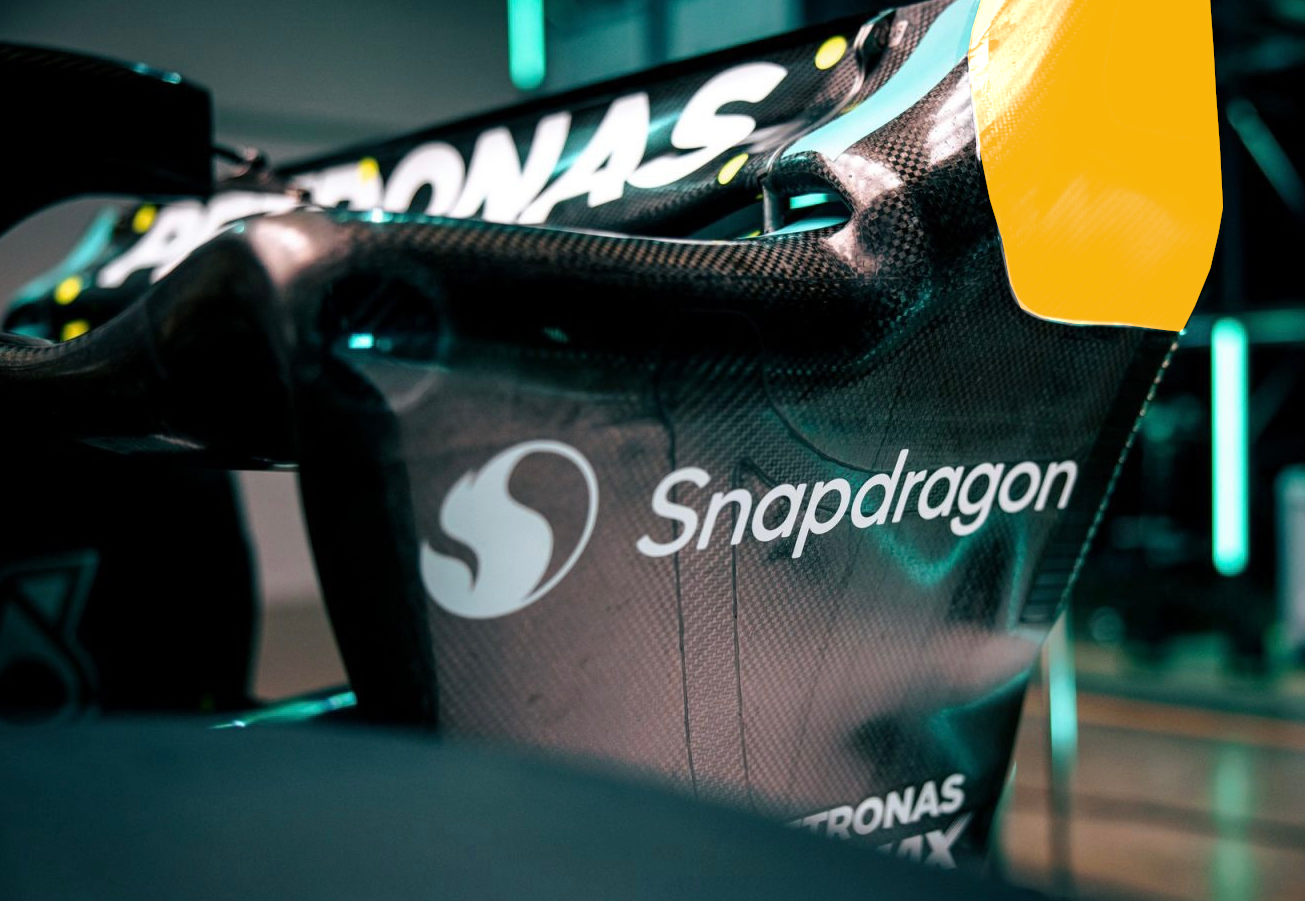
Photo: Mercedes-AMG PETRONAS F1 Team
The rear wing - supported by a single pillar - features a design already seen on the W13, with endplates that "mimic" the ones contemplated until 2021 by the Technical Regulations. In this case, the aerodynamic advantage consists in keeping the suction side and the pressure side of the rear wing well separated. These are two areas that work with airflow at different pressures (principle on which, as seen, the generation of aerodynamic downforce is based).
What prospects for Hamilton and Russell with the new Mercedes W14?
The main problem that gripped the W13 throughout 2022 was the inability to keep the aerodynamic platform stable, a factor which on more than one occasion triggered major porpoising… consequently, in many Grands Prix it was impossible for the engineers from Brackley to put on the track a car with a low ride height setup, which penalized performance.
The Anglo-German team is trying to give a totally different outcome to the 2023 World Championship by putting on track a product characterized by stubborn technical choices, but supported by the knowledge acquired through defeats in 2022.
“I don't think we've ever been a team that copies others. We've always been a team of our own ideas, incredibly creative and innovative, and we've always liked to do things our own way. And I think this has worked in the past"
Lewis Hamilton
If this new single-seater can remedy the problems mentioned, its level of competitiveness will certainly make a leap forward enough to worry the competition. Meanwhile, the first rumours speak of an aerodynamic update package ready for the first races... As always, the track will give its answers!
Index
Mercedes W14: plenty of room for creativity in a myriad of technical evolutions!
- Back to black: black livery looking for a few kg less!
- Higher nose and new front wing with endplate that will cause controversy
- Have the zeropods been maintained? Meanwhile, the W14 features an engine cover with two brand new channels!
- Rear end with few upgrades, but expect some surprises…
- What prospects for Hamilton and Russell with the new Mercedes W14?